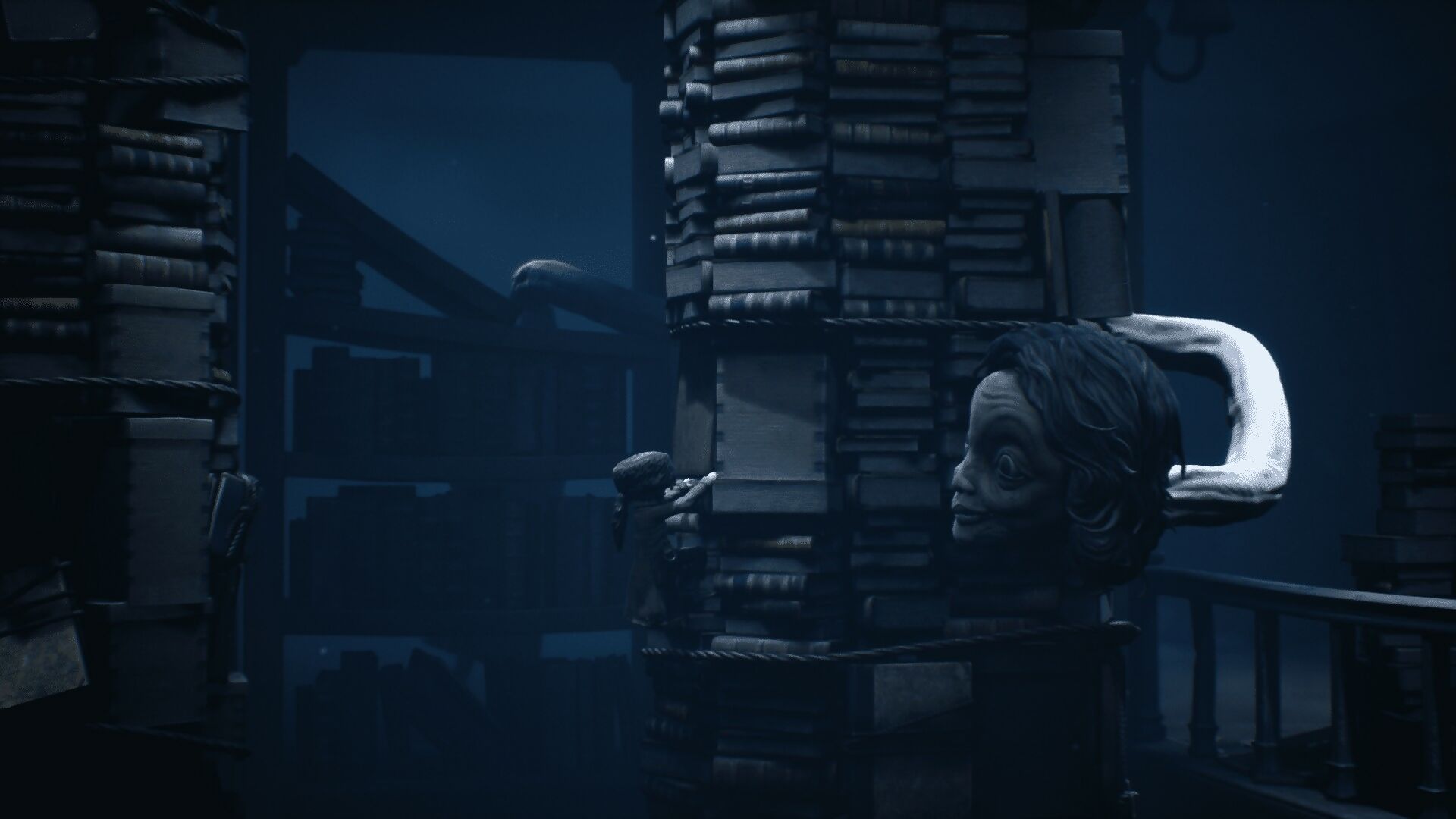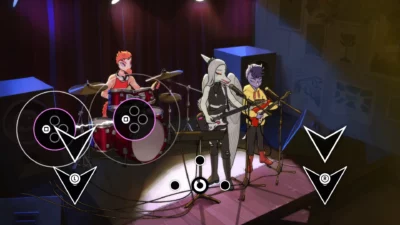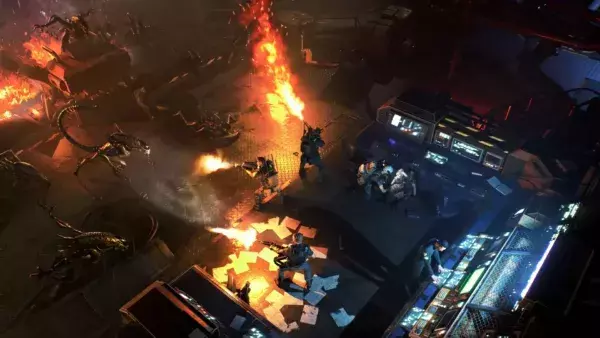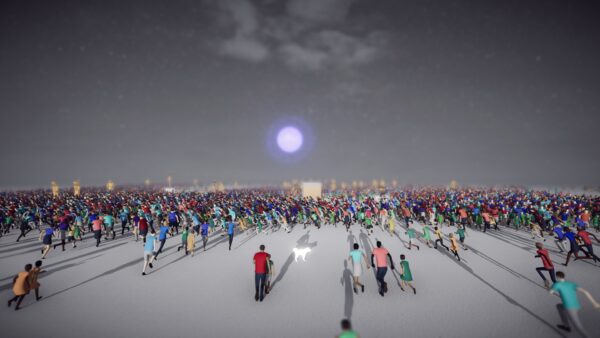
For a work so obsessed with the iconography of out-of-tune televisions, made by an industry still shackled to cinematic aspirations, it’s refreshing to discover that Tarsier’s sequel takes its cues from a more time-honoured narrative medium: Little Nightmares II is one of the most theatrical games ever made.
Rare is the scene where a single element doesn’t dominate, positioned centre-stage and lit by a flickering bulb, hazy TV static, or moonlight from an open window. Meanwhile, the edges of the screen remain in shadow, like a stage set for the protagonist to deliver some near-death soliloquy.
Complemented by the developer’s extraordinary ability to conjure memorable images that combine the childlike and the grotesque, the fairy tale and the horror story, this stylistic choice results in another interesting side effect: it foregrounds said elements’ already heavy symbolic connotations. In the opening’s forest, you don’t use a rope to cross a gaping chasm, you use a hangman’s noose.
Later on, inside a wooden shack, the key you need to escape isn’t left lying on top of some drawer, but dangles from a meat hook. To get there, you have to climb what elsewhere might be a harmless rolled-up carpet, but here looks like a bulging chrysalis ready to burst with life at the slightest mishap. Under the spotlight, props ascend to the status of symbols, platforming challenges are reframed as existential struggles; everything is supercharged with meaning.
Which makes sense. Isn’t that how both Mono, our new lead, and Six, beloved heroine of the original who joins him, would view this oppressive, brutal universe through their adolescent eyes?
Not that innocence is an option in a world where every room hides a decomposing corpse, plastic mannequins come alive with murderous intent, and mesmerised citizens fly into fits of destructive rage the moment their TV-induced oblivion gets interrupted.

Once she retrieves her iconic costume, Six cuts a striking figure among the drab backgrounds.
Adding limited offensive options to your repertoire of abilities, the most shocking violence in Little Nightmares II isn’t the kind visited on you, but the kind you inflict upon others, like shattering the pupils of the second level’s twisted academy into porcelain fragments with a lead pipe, or finally serving the hunter in the woods with a taste of his own medicine.
Still, for the most part, you’re as helpless as in the first game, and these intermittent moments of morally ambiguous empowerment do more to highlight your vulnerability than deflate it.
Occasional bouts of armed resistance aside, most of your time will be spent with light platforming and rudimentary puzzle-solving, and it’s here that an otherwise dazzling audio-visual package falters. As if anxious to share its stunning imagery, Little Nightmares II shirks from challenging you in the slightest, letting you cruise through considerable chunks of the game by simply moving from left to right, with the occasional button press to grab an overhead ledge or dive behind piles of scenery to evade the stare of each area’s prowling stalker.
Worse, when navigation does become a problem, it’s not due to devious spatial design making demands of your skills, but because of frequent hitches in the controls, like the way Mono tends to cling to background objects, slowing his pace to a crawl – a disaster when chased down a cluttered corridor.
Environmental puzzles tend to be similarly trivial: pulley, meet analogue stick. Later levels, at least, add some sophistication, and there are some great, panic-inducing sequences in the creepy Hospital area involving your flashlight, but even near the endgame, you’ll rarely need more time to come up with solutions than it takes for a glance at the screen and, perhaps, a quick test with available objects of interaction.

Innocence lost, a central theme in the game, is reflected in the decrepit state of this room.
While the lack of challenge might be useful in securing a relatively unimpeded narrative flow, it comes with a loss of achievement, the feeling that, rather than an integral part of the triumph-over-adversity story being told, you’re just someone along for the ride.
Nevertheless, it’s hard to complain about trouble-free progress when the rewards are so enticing. Improving on the original’s already exquisite squalor and expanding its gallery of claymation monstrosities means that Little Nightmares II appeals primarily as a never-ending stream of visual delights.
Interiors are richly detailed monuments to neglect, rooms filled with faded memorabilia, abandoned toys, and broken appliances, signifiers of lives suspended, now covered with a coat of fine dust. But even those sights can’t compare to the sprawling vistas and ominous towers of the Pale City, usually glimpsed inbetween levels in all its concrete grandeur. Sound is also masterfully deployed to flesh out this menacing realm in more subtle ways, adding a layer of physicality to the bear traps or the piano whose keys feebly thud, stringless, as you step on them to reach higher ground.
The journey doesn’t last long, which counts among the game’s merits as you’re barely given the time to register its flaws: the lack of challenge, the unwieldy controls, and even a certain thematic laxity, the fact that, for all of their symbolic charge, its ciphers never congeal into a full metaphor.
Instead, Little Nightmares II is happy to take you on a brisk tour of its beautifully decaying world before letting go with an emotionally savage final act. After all, you’ve come to know these characters (or so you think) and finding out how their harrowing experience has shaped them makes for a last, shocking flourish before the curtain call.
Highlight
The Hospital, packed to the rafters with plastic limbs and inhabited by a throng of headless dummies that grow restless in the dark, isn’t just the creepiest level in the game, but also one where the flashlight gimmick provides the kind of engagement to match the peerless audio-visual presentation.
Verdict: 64%
A gorgeous world to visit, even if the game built around it is anodyne.
Genre: Puzzle-platformer
Format: PC (tested) / PS4 / PS5 / XBO / XB X/S / Switch / Stadia
Developer: Tarsier Studios
Publisher: Bandai Namco Entertainment
Price: £24.99
Release: Out now





